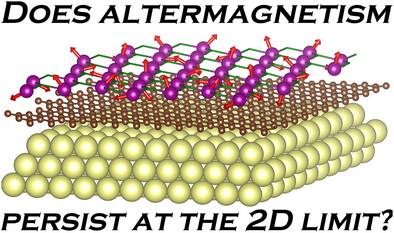交替磁体MnTe二维极限下的紧急磁结构
IF 19
1区 材料科学
Q1 CHEMISTRY, MULTIDISCIPLINARY
引用次数: 0
摘要
MnTe最近作为一种典型的交替磁体出现,这是一种新发现的磁性,其特征是补偿反铁磁有序与自旋分裂电子带共存,传统上被认为是铁磁体所独有的。然而,当交替磁体变薄到二维极限时,交替磁性的持续程度在很大程度上仍未被探索。本文通过实验扫描隧道显微镜、x射线光电子显微镜、x射线吸收光谱和x射线磁性圆二色性以及密度泛函理论计算,研究了二维(2D) MnTe的磁性行为,特别是石墨烯/Ir(111)衬底上生长的原子薄单层(MLs)和双层(BLs)。研究发现,虽然ML和BL MnTe采用的原子结构的对称性与电磁不相容,但它们表现出有趣的磁相:BL形成了具有平面内自旋各向异性的高鲁棒层状反铁磁体,而ML在其冻结温度以下表现出自旋玻璃行为相容的特征,这是以前在原子薄材料中未观察到的现象。这些发现强调了降维是如何促进不同于3D结构的不寻常磁性结构的出现的,为低维磁性提供了新的见解。本文章由计算机程序翻译,如有差异,请以英文原文为准。

Emergent Magnetic Structures at the 2D Limit of the Altermagnet MnTe
MnTe has recently emerged as a canonical altermagnet, a newly identified class of magnetism characterized by compensated antiferromagnetic order coexisting with spin-split electronic bands, traditionally considered exclusive to ferromagnets. However, the extent to which altermagnetism persists as altermagnets are thinned to the 2D limit remains largely unexplored. Here, the magnetic behavior of two-dimensional (2D) MnTe is investigated, specifically atomically-thin monolayers (MLs) and bilayers (BLs) grown on graphene/Ir(111) substrate, by combining experimental scanning tunneling microscopy, X-ray photoelectron microscopy, X-ray absorption spectroscopy, and X-ray magnetic circular dichroism with density functional theory calculations. It is found that while ML and BL MnTe adopt atomic structures with symmetries incompatible with altermagnetism, they exhibit intriguing magnetic phases: the BL forms a highly-robust layered antiferromagnet with in-plane spin anisotropy, whereas the ML presents characteristics compatible with spin-glass behavior below its freezing temperature, a phenomenon not previously observed in an atomically thin material. These findings highlight how reduced dimensionality can promote the emergence of unusual magnetic structures distinct from those of their 3D counterparts, providing new insights into low-dimensional magnetism.
求助全文
通过发布文献求助,成功后即可免费获取论文全文。
去求助
来源期刊

Advanced Functional Materials
工程技术-材料科学:综合
CiteScore
29.50
自引率
4.20%
发文量
2086
审稿时长
2.1 months
期刊介绍:
Firmly established as a top-tier materials science journal, Advanced Functional Materials reports breakthrough research in all aspects of materials science, including nanotechnology, chemistry, physics, and biology every week.
Advanced Functional Materials is known for its rapid and fair peer review, quality content, and high impact, making it the first choice of the international materials science community.
 求助内容:
求助内容: 应助结果提醒方式:
应助结果提醒方式:


